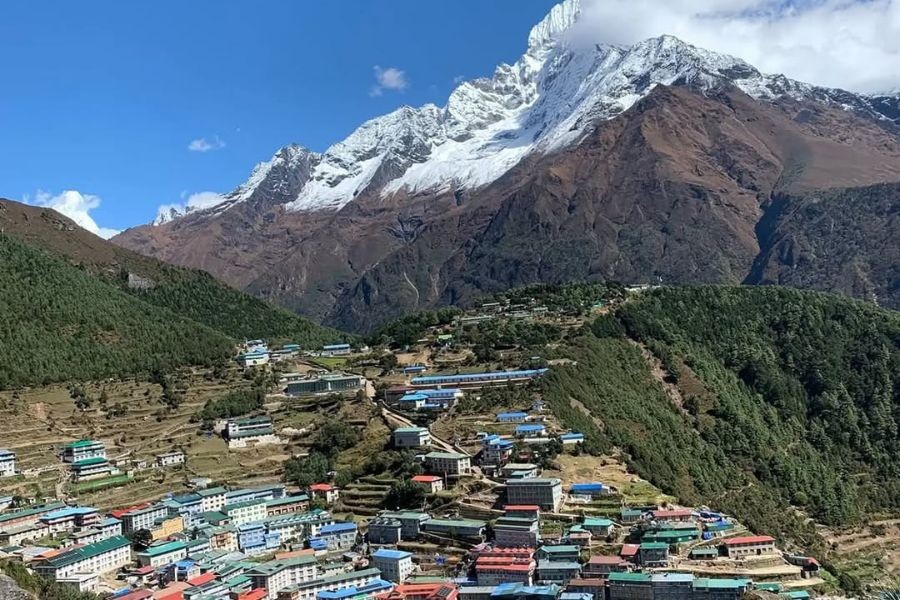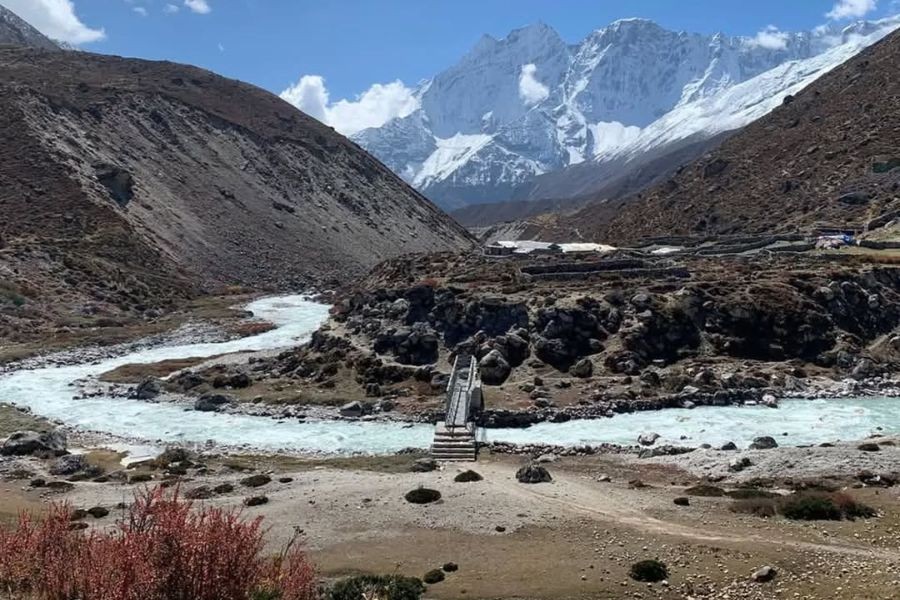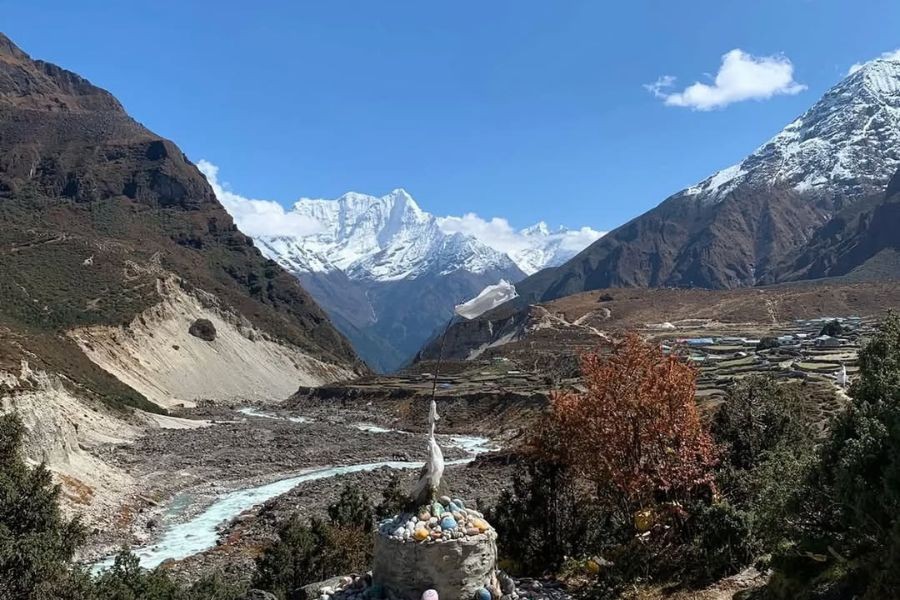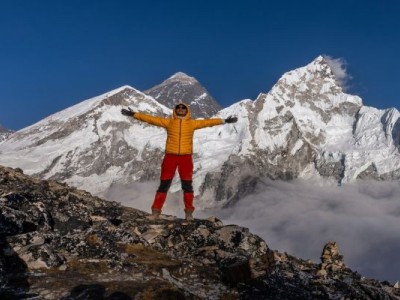Strategically timing your journey to the highest mountain on the planet is important. The best time to go on the trek to Everest Base Camp will naturally depend on the weather, trail conditions, and your own preferences for the crowd and scenery. When you know when to do the trek, the experience goes from being a difficult endeavor to being the trek of a lifetime. Whether you have a passion for crisp autumn skies, stunning rhododendrons in spring, or the beautiful solitude of winter trails, there are distinct advantages to every season of trekking to Everest base camp. This guide will cover what the best months are for your EBC trek and help you determine when the best time is to go on this historic Himalayan trek, which is on par with world-famous treks such as the Annapurna Circuit and Langtang Valley trek.
Table of Contents
Why Timing Matters for EBC Trek
Importance of Weather and Visibility
Choosing when to embark on your trek to Everest Base Camp is critical for safety and quality of experience. Weather in the Khumbu can change quickly at any time of year, from sunny, predictable days perfect for trekking to snowstorms that can make the trail unpassable. When the weather is clear, trekkers can look at the peaks of Everest, Lhotse, Nuptse, and Ama Dablam all in their glory. Conversely, cloudy weather will yield little visibility to the surrounding peaks that make trekking up the Khumbu Valley so special, and cloudy weather also increases safety concerns on the trail.
Effects on the Experience
The season you choose will impact every part of your trek. During peak seasons, expect teahouses to be full with other trekkers, with a lively social atmosphere–it's certainly best to book a teahouse in advance. Off-season trekking will likely mean fewer choices of sleeping/more solitary experiences, as well as lower prices, lower availability of shops/services, and/or colder weather. Flight reliability to Lukla will also tend to differ greatly depending on the season. In the fall or the spring, you can typically count on reliable flight schedules to Lukla, but flights are often delayed in the winter and in monsoon season, and this can change frequently, too.
Overview of Everest Base Camp Trek Climate and Weather

The EBC trek moves you from Lukla (2,840m) to Base Camp (5,364m), covering a variety of climate zones. The daytime peak season temperatures in Namche Bazaar (3,440m) are around 10-15°C, while the nighttime temperatures are down to -5°C. The nighttime temperatures in Gorak Shep (5,164m) can even be between -10°C and -15°C, even in good seasons.
The general weather patterns in the Everest region have a yearly pattern. Pre-monsoon months (March-May) provide gradually increasing temperatures in the days and more afternoon clouds. Monsoon (June-August) brings heavy rains to lower elevations, although not to the level of rain from areas such as the Annapurna Base Camp trek. In post-monsoon fall (September-November), you will see the best weather, mostly in the form of clear skies and limited rain.
Everest Base Camp Trek by Season
Spring (March to May): Blooming Trails & Clear Views
Spring is considered one of the two best times of year to hike to Everest Base Camp. The Khumbu region comes to life as winter releases its hold and the rhododendrons begin to bloom and color the hillsides. March may still be a chillier time, but mild days start to appear through the month of May with 15-20°C daytime temperatures at the lower elevations. The early part of Spring (March-April) usually has great visibility and clear skies in the morning, while the middle of spring (late April and May) has an increase of clouds in the afternoon.
Benefits: Longer daylight hours; flourishing vegetation; active wildlife; lodges open for business; flight schedules to Lukla; and excitement from mountaineers who attempt to summit Everest this time of year.
Disadvantages: warm weather with the late spring months; more trekkers means a busier trail system and the need to pre-book lodging, and prices tend to be higher during the absolute peak months.
Summer/Monsoon (June to August): Fewer Crowds & Greenery
The monsoon is considered the trekking season to avoid for most people heading to the Everest base camp, but there are thrilling benefits to this season. The Everest area lies in a rain shadow and receives much less overall precipitation than you'd think. The temperatures are warm, sometimes into the 25°C range, making for pleasant trekking days at the start. The rain tends to arrive as afternoon thunderstorms with periods of sun before and after rather than an all-day downpour.
Benefits: It is a dramatically less busy trek, with peaceful trails, easy accommodation bookings, significantly cheaper, and incredibly lush green landscapes with waterfalls everywhere.
Challenges: Muddy, slippery sections of trail, leeches on the forested trail sections below 3,000m, clouds cover the view of the mountains, and more delays with Lukla flights.
Autumn (September to November): Ideal Weather & Visibility
For many trekkers, autumn is the best season to trek to Everest Base Camp. After the monsoon rains, the associated dust and haze have disappeared, and the majestic Himalayas appear in all their glory. The weather in September is mild with some clouds, and by October, it is often just perfect. Temperatures during the day are pleasant (10-15°C), and autumn has the year's best visibility with clear skies.
Benefits: More stable weather than other seasons, fewer days disrupted in terms of weather, the best chances for flights to and from Lukla, post-monsoon freshness, and the vibrant vegetation, plus the indigenous culture of Nepal, such as Dashain and Tihar celebrations. Most trekkers say autumn is an excellent experience and closely resembles the traditional EBC trek.
Challenges: Crowded trails, especially in October, the need to book teahouse rooms ahead of time, peak-season pricing, and busy vantage points, especially at Kala Patthar, detract from the wilderness experience.
Winter (December to February): Quiet Trails & Snow-Covered Peaks
For the best time to visit for isolation and unblemished snow-covered scenery, winter provides the most remarkable Everest base camp trek. Be prepared for extremely cold temperatures, with nighttime lows falling to -20°C at higher elevations. Daytime temperatures are bearable in the lower elevations (5-10°C in the sun). Winter offers incredibly clear skies and razor-sharp mountain views, both of which are ideal for images.
Benefits: Near-deserted trails, a real wilderness experience, drastically lower costs for lodging, a wider selection of accommodations, personalized service in the teahouses, and landscapes that have a unique transformation due to snow.
Obstacles: Very cold temperatures necessitating extensive preparation and top-quality gear, some higher elevation teahouses will be closed, icy trails (microspikes needed), more delays for flights to/from Lukla, shorter hours of daylight, and risks for altitude sickness in very cold temperatures.
Best Months for Everest Base Camp Trek

April: For many, it is the best single month for the trek to base camp, considering the wonderful weather and blooming rhododendrons with a reasonable number of people on the popular route. There is also some atmosphere from the mountain climbing expeditions, and comfortable temperatures mean flights from Lukla are reliable.
May: The good weather continues, but the last week of May sees clouds increasing as the weather will start changing to pre-monsoon patterns. The crowds at this time turn to peak level, and spring prices reach their highest.
September: The weather starts post-monsoon, and it takes a few days to reach full clarity, with the clouds improving visibility every day thereafter. September is a great compromise month as the crowd levels are moderate compared to October, and the views are clear.
October: It's the peak month for autumn and arguably any time of year. Most trekkers enjoy perfect weather, great visibility, and stable conditions, so they will be here, i.e., very busy. When coupled with the festival season and cultural dimension, it's quite rich.
November: Great weather continues through the early part of the month, but temperatures start dropping as winter arrives. Visibility stays great, and availability is better than in October.
March: The shoulder season is getting better, but retains cold weather. Less busy than the previous two months, with fewer people. Most of the high passes will still have some snow on them and get cold.
December-February: Your hardest months of the year are extremes of cold and short daylight. All trekkers are now avoided in these months, although you will find perfect solitude, crystal clear views, no companies, and no other trekkers.
Crowd Levels and Trail Conditions
The peak months (April-May and October-November) turn the EBC trail into an active thoroughfare for trekkers from all over the world. Teahouses are filled with conversations in a dozen languages. Popular stops, such as Namche Bazaar and Tengboche Monastery, are overrun with activity. It is hard not to be carried along by the fun energy of trekkers swapping stories, or simply talking about where they have been from around the world.
Off-season trekking (December-February and June-August) is an entirely different experience. You may go hours or even a whole day without seeing another trekker. Teahouses feel considerably less like a business and more like a family stay. The silence in the mountains takes on a different quality altogether.
Trail conditions change considerably. Spring and autumn provide the best surface conditions, with dry, well-defined pathways; thus, nothing more than a basic pair of boots is required. Monsoon will create muddy and slippery sections of trail, which will require reaching for foot placements. Winter will introduce snow and ice on the trail, necessitating the use of microspikes as your ascent for Kala Patthar approaches..
Photography and Scenery by Season

For photographers, the months of October and November provide the most consistently great conditions with crystal-clear skies, perfect light, and minimal atmospheric haze. Likewise, April presents unparalleled opportunities when rhododendrons bloom and create incredibly vivid foregrounds for mountain compositions.
Winter photography can be worth suffering through extreme cold for the pristine snow landscape and exceptionally clear air. With a completely changed landscape due to frozen waterfalls and snow-covered evergreens, plus a near monochrome palette of colors, winter provides creative opportunities not found in other seasons.
Each season paints the Khumbu landscape in varying degrees. In spring, the lower elevations turn colorful with blooming rhododendrons, magnolias, and wildflowers. The summer monsoon yields the year's most green landscapes because of the cascading waterfalls, but the clouds do block views of the mountains. Autumn, in a dramatic fashion, displays the landscapes very clearly, with sharp peaks against the deep blue skies. The winter converts the whole area into an alpine fantasy with pristine white landscapes.
Festival Seasons and Cultural Experiences
Scheduling your trekking experience with local festivals provides invaluable cultural richness. One example would be the Mani Rimdu Festival at Tengboche Monastery, usually occurring in October or November, which is a key Buddhist festival celebration in the Himalayas. This festival includes local monks performing traditional Cham dances in colourful costumes while the monastery fills with local people dressed in traditional garb.
Another cultural experience, which takes place during the fall, can be found at Dashain and Tihar, Nepal's biggest festivals that usually fall during September to October. Many of Nepal's other great treks, such as the Upper Mustang trek, will provide similar cultural experiences with ancient Tibetan Buddhist traditions still substantially preserved.
Expert Recommendations: When Should You Go?

Ideal Time for First-Time Trekkers
Professionals repeatedly suggest October for first-time treks because of the great weather, great safety, and developed infrastructure. April is an all-around excellent time to trek in Nepal, with nearly all the same conditions as the blooming rhododendrons. Generally, for first-time trekkers, the monsoon and winter should be avoided unless you have an incredible amount of trekking experience. For better examples of your high altitude experience, trek the shorter high-altitude treks in Nepal, like the Langtang Valley trek, before attempting EBC in difficult seasons.
Best Season For Adventure Seekers and Photographers
Adventure Seekers often find the winter EBC trekking experiences to be the most rewarding. Extreme conditions, empty trails, and stunning landscapes covered in snow all balance the expedition feel. Winter also attracts the photographer seeking a vantage point of the transformed landscape and extreme invisibility.
For photographers seeking the ideal photography conditions, autumn is king. October and November consistently offer good photography conditions with clear skies, perfect visibility, and reliable weather. Spring is for the photographers who are into mountain photography, as well as botanical photography, and photos among the rhododendrons are in bloom.
Tips for Choosing the Right Season for You

Fitness Level and Preparation
The highest elevation seasons (spring and fall) will typically suffice for moderate levels of conditioning. Winter will require more fitness and cardiovascular resilience, and it should be mentioned that extreme cold stresses your body beyond just high altitude considerations. The monsoon season requires different considerations—muddy trails can be treacherous, and the tendency to stress the knees is a reality.
Regardless of the season, proper acclimatization is key. Most itineraries provide for acclimatization and resting in Namche Bazaar and Dingboche. Take what you need to prepare your body with cardiovascular training, strength training exercises for your legs, and simulate the trek by practicing hiking a few hikes with a bit of weight on it.
Packing and Equipment for Weather
Spring and fall trekkers need fairly standard four-season sleeping bags (rated to -10) and can typically operate on lighter layering systems as needed. Winter usually calls for some harder-to-find equipment (expedition sleeping bag rated to -20, insulated down pants, heavy-duty mittens, face protection, and microspikes if the trails are icy).
Monsoon season requires excellent rain protection (a good-quality waterproof jacket and pants, a waterproof pack cover, and quick-dry clothing). This is the same for all seasons, let's remember good quality trekking boots, winter boots can be insulated ones.
FAQs
When is the best time of year to trek to Everest Base Camp?
The prime trekking seasons for Everest Base Camp occur in the autumn months (September-November) and spring months (March-May). Autumn, especially October, is often hailed as the best time to go because of its relatively stable weather, visibility, and comfortable temperatures! While spring provides many of the same benefits, and the added enjoyment of blooming rhododendrons!
When Can You Trek to Everest Base Camp?
You can trek the Everest Base Camp year-round! The trail is accessible even in the winter (December-February) and monsoon (June-August) months, though these seasons do require more preparation. Winter, for example, requires cold-weather gear for the extreme cold, while the monsoon is characterized by rain and restricted visibility of the mountains.
When is the best time to trek to Everest Base Camp to see the mountains?
October and November provide the best visibility of the mountains with crystal clear skies after the monsoon. December through February also provides excellent visibility; however, this comes with extreme cold! April and early May also provide very good visibility, but it is very common to have more clouds by the afternoon from late May onwards.
How crowded is the Everest Base Camp trek in different seasons?
The peak seasons (October-November and April-May) will usually be crowded with fully booked teahouses. October will be the busiest month. The monsoon season (June-August) and winter (December-February) will usually have quiet and peaceful trails with few crowds and teahouses available for accommodation.
What should I pack differently during each Everest Base Camp trekking season?
Spring and autumn will require regular four-season hiking gear, such as a -10 °C sleeping bag and down jacket. Winter will require expedition-level equipment, such as a -20 °C sleeping bag, insulated down pants, heavy mittens, and microspikes. The monsoon season will require good waterproof clothing and quick-dry clothing.
Conclusion: Plan Your Everest Adventure Smartly
Deciding when to attempt your Everest Base Camp trek boils down to a juggling act of weather conditions, crowds if you prefer to avoid others, and your own ambitions. For most trekkers, autumn (with a focus on October) and spring (with an eye on April) provide the best balance of reliable weather, good visibility, and comfortable conditions.
That said, if you feel that the possibility of trekking during the off-season aligns with your circumstances (like your personal time limitations), it still has its merits. Winter undeniably brings unparalleled solitude for the experienced mountain adventurer, and a monsoon trek does offer budget options. Each Everest base camp trekking season has its own benefits that might well fit your trekking style.
Keep in mind that the best month for your Everest base camp trek is personal to each trekker. Be honest with yourself in terms of your priorities, capacities, and limitations to best support the most appropriate season for your needs. Considerations aside from the time of year, know that whether it is time to travel, you should travel camping with respect — leave no trace principles (in terms of waste), support local communities, and show respect to the rich Sherpa culture.
If you are planning your first trek in the Himalaya to Everest Base Camp, or if this is your first return from having trekked (or some experience trekking) on iconic routes such as the Gokyo Lakes trek, or the Manaslu Circuit trek, getting the timing right will take your trip from good to unforgettable. Start your planning today with those considerations of seasonable opportunities in mind, and be excited about trekking to the touch, the Everest Base Camp experience you have dreamt of viewing the world's highest mountain will be the trip of a lifetime.
Make an inquire to trek Everest base camp with Himalayan Ecological Trekking!
Inquire Now: [email protected]
Expert Consultation: WhatsApp: +977 9851006023 (Bikesh)
.jpg)


